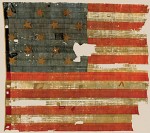… took place on this date in 1857. Here’s what Mark Twain wrote about it in Roughing It 15 years later:
The persecutions which the Mormons suffered so long—and which they consider they still suffer in not being allowed to govern themselves—they have endeavored and are still endeavoring to repay. The now almost forgotten “Mountain Meadows massacre” was their work. It was very famous in its day. The whole United States rang with its horrors. A few items will refresh the reader’s memory. A great emigrant train from Missouri and Arkansas passed through Salt Lake City and a few disaffected Mormons joined it for the sake of the strong protection it afforded for their escape. In that matter lay sufficient cause for hot retaliation by the Mormon chiefs. Besides, these one hundred and forty-five or one hundred and fifty unsuspecting emigrants being in part from Arkansas, where a noted Mormon missionary had lately been killed, and in part from Missouri, a State remembered with execrations as a bitter persecutor of the saints when they were few and poor and friendless, here were substantial additional grounds for lack of love for these wayfarers. And finally, this train was rich, very rich in cattle, horses, mules and other property—and how could the Mormons consistently keep up their coveted resemblance to the Israelitish tribes and not seize the “spoil” of an enemy when the Lord had so manifestly “delivered it into their hand?”
Wherefore, according to Mrs. C. V. Waite’s entertaining book, “The Mormon Prophet,” it transpired that—
A “revelation” from Brigham Young, as Great Grand Archee or God, was dispatched to President J. C. Haight, Bishop Higbee and J. D. Lee (adopted son of Brigham), commanding them to raise all the forces they could muster and trust, follow those cursed Gentiles (soread the revelation), attack them disguised as Indians, and with the arrows of the Almighty make a clean sweep of them, and leave none to tell the tale; and if they needed any assistance they were commanded to hire the Indians as their allies, promising them a share of the booty. They were to be neither slothful nor negligent in their duty, and to be punctual in sending the teams back to him before winter set in, for this was the mandate of Almighty God.
The command of the “revelation” was faithfully obeyed. A large party of Mormons, painted and tricked out as Indians, overtook the train of emigrant wagons some three hundred miles south of Salt Lake City, and made an attack. But the emigrants threw up earthworks, made fortresses of their wagons and defended themselves gallantly and successfully for five days! Your Missouri or Arkansas gentleman is not much afraid of the sort of scurvy apologies for “Indians” which the southern part of Utah affords. He would stand up and fight five hundred of them.
At the end of the five days the Mormons tried military strategy. They retired to the upper end of the “Meadows,” resumed civilized apparel, washed off their paint, and then, heavily armed, drove down in wagons to the beleaguered emigrants, bearing a flag of truce! When the emigrants saw white men coming they threw down their guns and welcomed them with cheer after cheer! And, all unconscious of the poetry of it, no doubt, they lifted a little child aloft, dressed in white, in answer to the flag of truce!
The leaders of the timely white “deliverers” were President Haight and Bishop John D. Lee, of the Mormon Church. Mr. Cradlebaugh, who served a term as a Federal Judge in Utah and afterward was sent to Congress from Nevada, tells in a speech delivered in Congress how these leaders next proceeded:
They professed to be on good terms with the Indians, and represented them as being very mad. They also proposed to intercede and settle the matter with the Indians. After several hours parley they, having (apparently) visited the Indians, gave the ultimatum of the savages; which was, that the emigrants should march out of their camp, leaving everything behind them, even their guns. It was promised by the Mormon bishops that they would bring a force and guard the emigrants back to the settlements. The terms were agreed to, the emigrants being desirous of saving the lives of their families. The Mormons retired, and subsequently appeared with thirty or forty armed men. The emigrants were marched out, the women and children in front and the men behind, the Mormon guard being in the rear. When they had marched in this way about a mile, at a given signal the slaughter commenced. The men were almost all shot down at the first fire from the guard. Two only escaped, who fled to the desert, and were followed one hundred and fifty miles before they were overtaken and slaughtered. The women and children ran on, two or three hundred yards further, when they were overtaken and with the aid of the Indians they were slaughtered. Seventeen individuals only, of all the emigrant party, were spared, and they were little children, the eldest of them being only seven years old. Thus, on the 10th day of September, 1857, was consummated one of the most cruel, cowardly and bloody murders known in our history.
The number of persons butchered by the Mormons on this occasion was one hundred and twenty.




 Several other boycotts against lettuce and strawberry growers were organized in following years. On February 14, 1968, UFW President Cesar Chavez began the first of many fasts in protest of the treatment of farm workers. During this first fast he received a strong letter of support from Martin Luther King Jr. …
Several other boycotts against lettuce and strawberry growers were organized in following years. On February 14, 1968, UFW President Cesar Chavez began the first of many fasts in protest of the treatment of farm workers. During this first fast he received a strong letter of support from Martin Luther King Jr. …